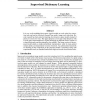Free Online Productivity Tools
i2Speak
i2Symbol
i2OCR
iTex2Img
iWeb2Print
iWeb2Shot
i2Type
iPdf2Split
iPdf2Merge
i2Bopomofo
i2Arabic
i2Style
i2Image
i2PDF
iLatex2Rtf
Sci2ools
180
click to vote
NIPS
2008
2008
Supervised Dictionary Learning
It is now well established that sparse signal models are well suited for restoration tasks and can be effectively learned from audio, image, and video data. Recent research has been aimed at learning discriminative sparse models instead of purely reconstructive ones. This paper proposes a new step in that direction, with a novel sparse representation for signals belonging to different classes in terms of a shared dictionary and discriminative class models. The linear version of the proposed model admits a simple probabilistic interpretation, while its most general variant admits an interpretation in terms of kernels. An optimization framework for learning all the components of the proposed model is presented, along with experimental results on standard handwritten digit and texture classification tasks.
Related Content
| Added | 30 Oct 2010 |
| Updated | 30 Oct 2010 |
| Type | Conference |
| Year | 2008 |
| Where | NIPS |
| Authors | Julien Mairal, Francis Bach, Jean Ponce, Guillermo Sapiro, Andrew Zisserman |
Comments (0)

